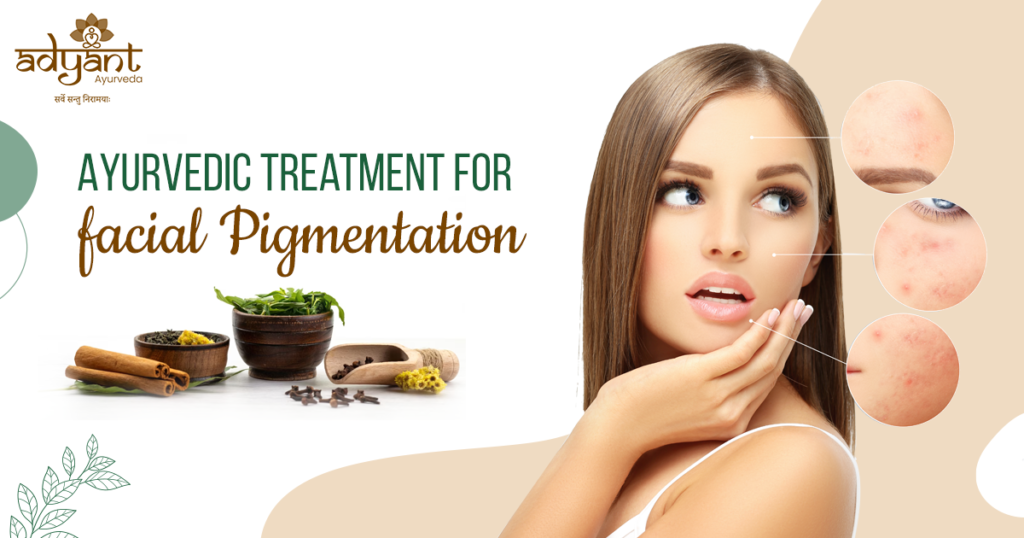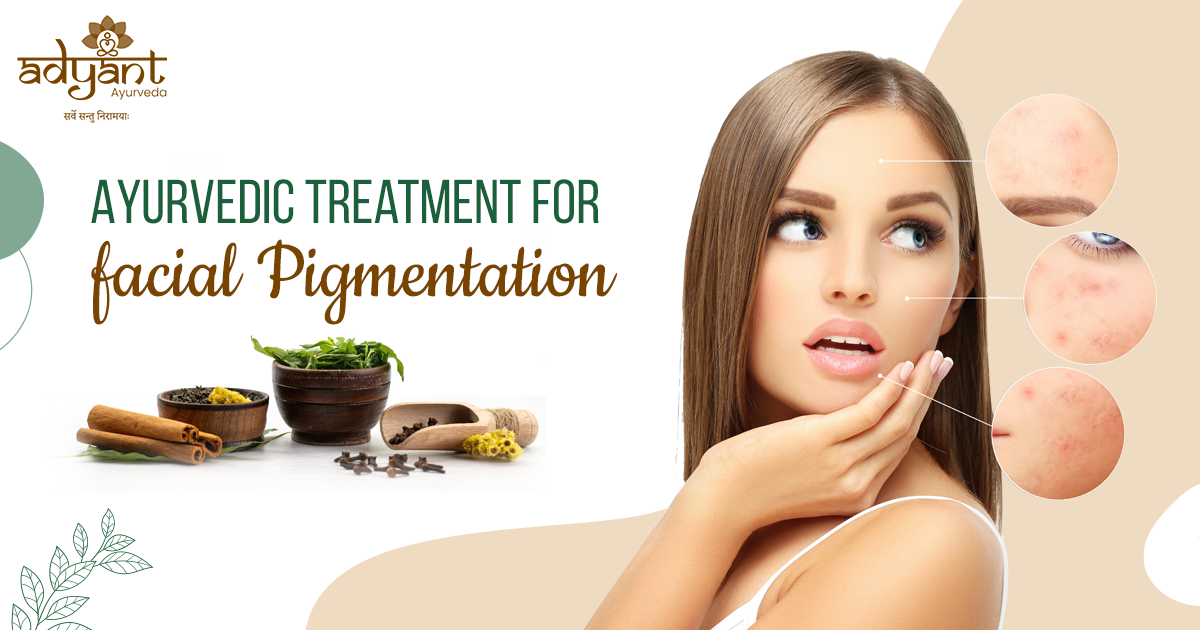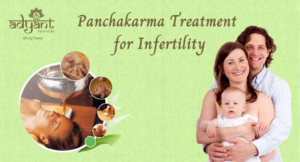
Facial Pigmentation Treatment in Ayurveda: Have you ever noticed stubborn dark patches on your skin that refuse to fade away, no matter what treatments you try? Facial pigmentation is a common dermatological concern caused by excessive melanin production. It manifests as dark spots, melasma, hyperpigmentation, or uneven skin tone. Factors like sun exposure, hormonal imbalance, pollution, and lifestyle habits contribute to this condition.
Unlike chemical treatments that offer temporary relief, Ayurveda provides a holistic approach by addressing the root cause of pigmentation. At Adyant Ayurveda, one of the top Ayurvedic hospitals in Bangalore, we specialize in natural pigmentation treatments using time-tested herbal formulations and therapies.
For a free consultation with top Ayurvedic doctors for Ayurvedic treatment for Facial Pigmentation, download our app from Play Store “AyurCare“
What Causes Facial Pigmentation?
Understanding the underlying causes of pigmentation helps in choosing the right treatment. Common causes include:
- Excessive Sun Exposure: UV rays trigger melanin production, leading to sunspots and tanning.
- Hormonal Imbalances: Conditions like PCOS, thyroid disorders, and pregnancy-related hormonal changes cause melasma.
- Stress & Lifestyle Factors: Irregular sleep patterns, poor diet, and high stress disrupt skin health.
- Inflammation & Skin Injuries: Acne scars, burns, or cuts may lead to post-inflammatory hyperpigmentation (PIH).
- Use of Chemical-Based Cosmetics: Harsh chemicals can damage the skin barrier, worsening pigmentation issues.
Ayurvedic Perspective on Facial Pigmentation
In Facial Pigmentation Treatment in Ayurveda, facial pigmentation is linked to an imbalance in Pitta Dosha (fire element) and excess accumulation of toxins (Ama) in the blood. So we have to reduce excess Pitta in your body. You can also read our blog on how to reduce Pitta Immediately.
Ayurvedic Principles for Pigmentation Treatment:
- Pitta-Pacifying Diet: Cooling foods like cucumber, coconut, and fresh fruits help balance Pitta.
- Detoxification (Panchakarma): Therapies like Virechana (Purgation Therapy) cleanse the liver and purify blood.
- Herbal Formulations: Natural remedies like Manjistha, Chandan, Yashtimadhu, and Amla effectively treat hyperpigmentation.
- External Applications: Ayurvedic face packs, herbal oils, and medicated lepas provide nourishment and improve skin tone.
Best Ayurvedic Treatments for Facial Pigmentation
1. Panchakarma Detox Therapy
A full-body detox removes deep-seated toxins that cause skin issues. The two most effective therapies include:
- Virechana (Purgation Therapy): Removes Pitta toxins, improving skin clarity.
- Raktamokshana (Bloodletting Therapy): Purifies blood to eliminate pigmentation issues.
2. Herbal Face Packs for Skin Brightening
- Manjistha & Sandalwood Pack: Reduces inflammation and brightens skin.
- Yashtimadhu & Turmeric Pack: Fades dark spots and provides a natural glow.
- Aloe Vera & Neem Paste: Soothes irritated skin and prevents acne marks.
3. Ayurvedic Internal Medications
- Manjistha Capsules: Powerful blood purifier for hyperpigmentation.
- Triphala Powder: Improves digestion and detoxifies the body.
- Amla Juice: Rich in Vitamin C, promotes collagen production and skin repair.
4. Abhyanga (Ayurvedic Oil Massage)
- Kumkumadi Tailam: A traditional Ayurvedic oil enriched with saffron, renowned for its skin-brightening properties.
- Nalparamadi Oil: Effective in reducing pigmentation and improving complexion.
5. Lifestyle and Dietary Recommendations
- Eat a balanced Pitta-pacifying diet, including cooling foods like coconut water, cucumber, and leafy greens.
- Avoid processed foods, excess salt, and spicy items that aggravate Pitta Dosha.
- Stay hydrated with herbal teas like licorice, rose, and mint tea.
- Practice yoga and meditation to manage stress-related pigmentation.
You May Also Like: Ayurvedic Treatment for Hyperpigmentation
Why Choose Adyant Ayurveda for Facial Pigmentation Treatment in Ayurveda?
Adyant Ayurveda is one of the leading Ayurvedic clinics in Bangalore, offering personalized treatments for pigmentation issues. Our approach includes:
- Expert Ayurvedic Doctors: Highly experienced in treating dermatological disorders.
- Customized Panchakarma Treatments: Tailored detox programs for each individual.
- 100% Natural Remedies: No chemicals or synthetic treatments, ensuring long-term results.
- Patient Success Stories: Hundreds of satisfied patients have regained clear, glowing skin.
Book Your Ayurvedic Consultation with top Ayurvedic Doctors in Bangalore Online.
FAQs on Facial Pigmentation Treatment in Ayurveda
1. How long does it take for Ayurvedic treatment to show results?
Ayurvedic treatments offer long-term results by treating the root cause. Visible improvements can be seen in 4-6 weeks, depending on the severity of pigmentation.
2. Are there any side effects of Ayurvedic pigmentation treatments?
No, Ayurveda uses 100% natural herbs and therapies, making it safe for all skin types.
3. Can Ayurveda treat melasma permanently?
Yes! Ayurvedic treatments like Panchakarma, herbal applications, and dietary modifications help in the permanent reduction of melasma by addressing internal imbalances.
4. What is the cost of Ayurvedic treatment for pigmentation at Adyant Ayurveda?
The cost varies based on treatment plans. A detailed consultation helps determine the best therapy for you. Contact us for customized pricing.
Conclusion: Say Goodbye to Facial Pigmentation with Ayurveda
Ayurveda offers a time-tested, natural, and holistic approach to treating facial pigmentation. By addressing internal imbalances and purifying the blood, Ayurvedic remedies not only eliminate pigmentation but also promote healthy, glowing skin.
If you’re struggling with stubborn pigmentation, book a consultation at Adyant Ayurveda today and experience the healing power of authentic Ayurvedic skincare.
Call Now: 9972541009 to schedule an appointment!






